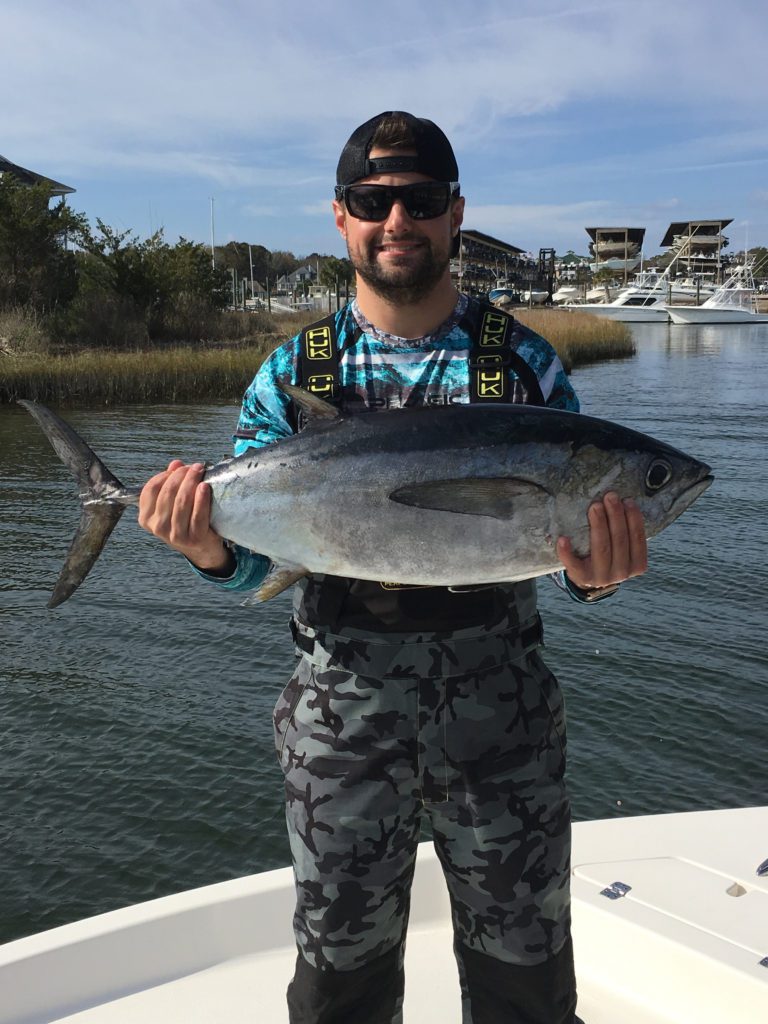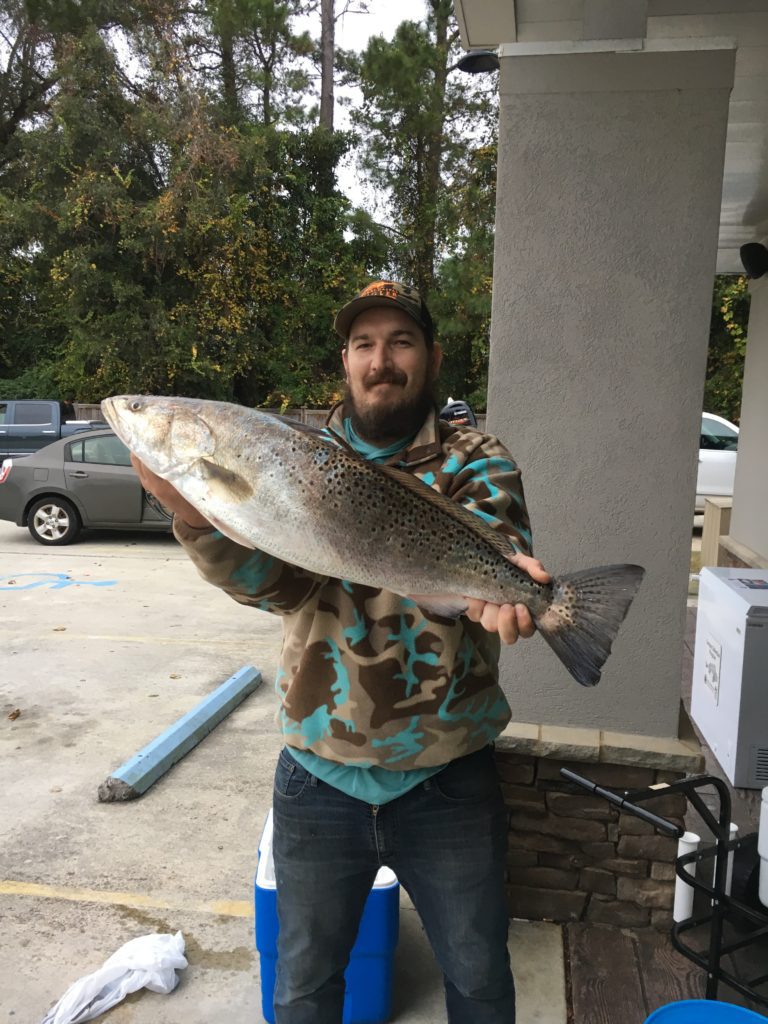Wrightsville Beach – December 14, 2017
Matt, of Tex’s Tackle, reports that the speckled trout bite remains strong, though the fish can be a little tougher to catch now that the weather is cooling down. The specks are hiding in basins and creeks where there is some bait present, but occasionally they will move onto flats and over shallow oyster bars where the sun has warmed the water up. Live shrimp and mud minnows are great for fooling the specks, especially when floated under a popping cork or slip float rig.
This winter expect to put a little more work in for the speckled trout bite. Suspending lures and light fluorocarbon leaders will be the keys to success over the coming months.
Red and black drum will begin to school up around docks during the winter, but they can usually be coaxed into the boat with Gulp shrimp, fresh shrimp, or cut mullet. On sunny days, they may still school up on the flats and back in the marsh.
While a few flounder are still inshore, most of them have headed offshore for the winter.
Surf fishing has been very productive, with large pompano and Virginia mullet coming in from the beach. Live shrimp and sand fleas are producing the most fish. The pompano will likely head out for the winter soon, but the mullet should stick around at least through January. Red drum will spend some time on the shoals around the inlets through the winter, and they can be caught on Gulps, gold spoons, and cut mullet.
Grey trout and flounder can be found on nearshore structure, and the flounder should remain in the 10-20 mile range all winter. Grouper and sea bass are also biting strong in the 10-20 mile range, but they’re likely to move even farther out as the water temperature drops. January and February can be great months to go a little farther offshore to drop some vertical jigs, and you may also find some amberjack, African pompano, grouper, triggerfish, and beeliners.
King fishing has been good, but most of the action is in the 40 mile range. Troll around ledges and live bottom areas, and look for schools of bait suspended in the water column. Drone spoons and frozen cigar minnows pulled from a downrigger or behind a planer will account for most of the fish.
Gulf Stream fishing has also been productive, with some 30+ lb. blackfins being reported. The bite on topwater poppers has been fantastic, but trolling lures, smaller diving plugs, and small ballyhoo will put fish in the boat as well.
Wahoo fishing has been hit or miss, but the bite could turn on at any moment. High speed lures are an effective way to cover more water and find the ‘hoos before dropping the planer rod and a spread of ballyhoo.
Arlen, of Intracoastal Angler, reports that speckled trout fishing has continued to be fantastic, with most of the catch coming in the early mornings or late evenings due to incredibly clear water conditions. Natural-colored soft plastics (such as Opening Night and Christmas Tree) rigged on 3/16 oz. jig heads, along with MirrOlure MR18s, have been the most effective baits for the specks, which can be found in deeper creeks behind Masonboro as well as the docks behind Figure 8. Through the winter, expect the specks to keep biting, especially along shallow, muddy areas in proximity to deep water.
Several red drum have been caught in the creeks, as well as in Masonboro Inlet along the jetty. Use MirrOlure TTs or live shrimp below a slip float to get a bite. Reds and a few black drum are also beginning to stage around deeper waterway docks for the winter, where Gulps and dead shrimp on jig heads are the most effective. The reds will also school up tightly in the surf, where, on calmer days, you will be able to sight cast to them from the boat.
Surf fishing has been phenomenal thanks to some of the best pompano and sea mullet fishing in years. The pompano have been up to 5 lbs., and the mullet have been around the 2.5 lb. range. Both are being caught primarily on live sand fleas by targeting areas around piers and the deeper holes along Wrightsville.
Black drum and speckled trout are being caught in the same surf zones, while blues and red drum are coming from the northern end of the island, mostly on cut mullet.
Albacore fishing has moved off the beach to the 5-10 mile range, and king action is best in the 20-25 mile range. Expect the albies to move even farther off into the winter.
Gag grouper and larger sea bass are being found in the same range, mostly around natural ledges and live bottoms in 80-90’ of water.
Several bluefin tuna have been landed by trolling horse ballyhoo on fluorocarbon rigs with Jag and Ilander skirts. The fish have been seen around bait pods from right on the beach to the Liberty Ship, and even as far offshore as 12 miles.
Jamie, of Seagate Charters, reports that trout fishing remains strong around Wrightsville Beach. High salinity creeks and boat basin-style areas have been very productive, with Gotcha and Blue Water Candy soft plastics getting most of the bites.
Red drum are feeding in the ICW, especially around docks. They, as well as a handful of black drum, have been happily taking shrimp.
Hit the surf for even more red drum action, where the reds can be caught either from the beach or, weather permitting, the boat.

Zach Shilen with a blackfin tuna caught near the 10 Mile Box Car. He was trolling for kings when the tuna begaun busting on the surface.
Trevor, of ProFishNC Charters, reports that trout have been on fire and will continue to be thick through early January, while inshore fishing in general will stay consistent throughout the winter, especially when using natural dead bait around deep water docks on warmer days.
The tautog bite that is just starting to take off will remain strong through March. Fish nearshore wrecks, rocky bottoms, and ledges with crabs or shrimp for the best results.
Black sea bass will be feeding from the jetty out to 5 miles all winter.
Rick, of Living Waters Guide Service, reports that kings and false albacore are schooling and slowly moving offshore, where they can be found at 15 miles and farther. The water offshore is still very warm, so fishing has been a little off from the norm—wahoo and sailfish have been slow, but blackfin tuna in the 30 lb. range are tearing up any bait being trolled, jigged, or popped.
Bottom fishing is still consistent for gags and scamps from depths of 80-100’. The assorted grunts, beeliners, pinkies, and sea bass are being picked up as well.
This winter, expect cooler water to push offshore and bring African pompano and other species to the break where you’ll be able to jig them. Trolling will be good for wahoo and blackfins around structure on the break.
Bottom fishing will produce grunts and sea bass in 75-100’ of water, with squid and metal jigs likely to bring in the most fish.

Ryan Christoffersen, of Intracoastal Angler, with a 9.75 lb. speckled trout caught on a Storm Shad near Wrightsville Beach.
Raven, of Johnnie Mercer’s Pier, reports that strong catches of bluefish, some drum, a few flounder, and lots of mullet have all been coming in, in addition to a recent surge in pompano and whiting. The pompano and whiting are being caught on shrimp and sand fleas.
Through the winter, the bite will stay strong as long as the water hangs in the low 60 degree range. If the water does drop a few more degrees, expect a stronger trout presence, but don’t be surprised to still find flounder, good-sized mullet, and the occasional drum.
